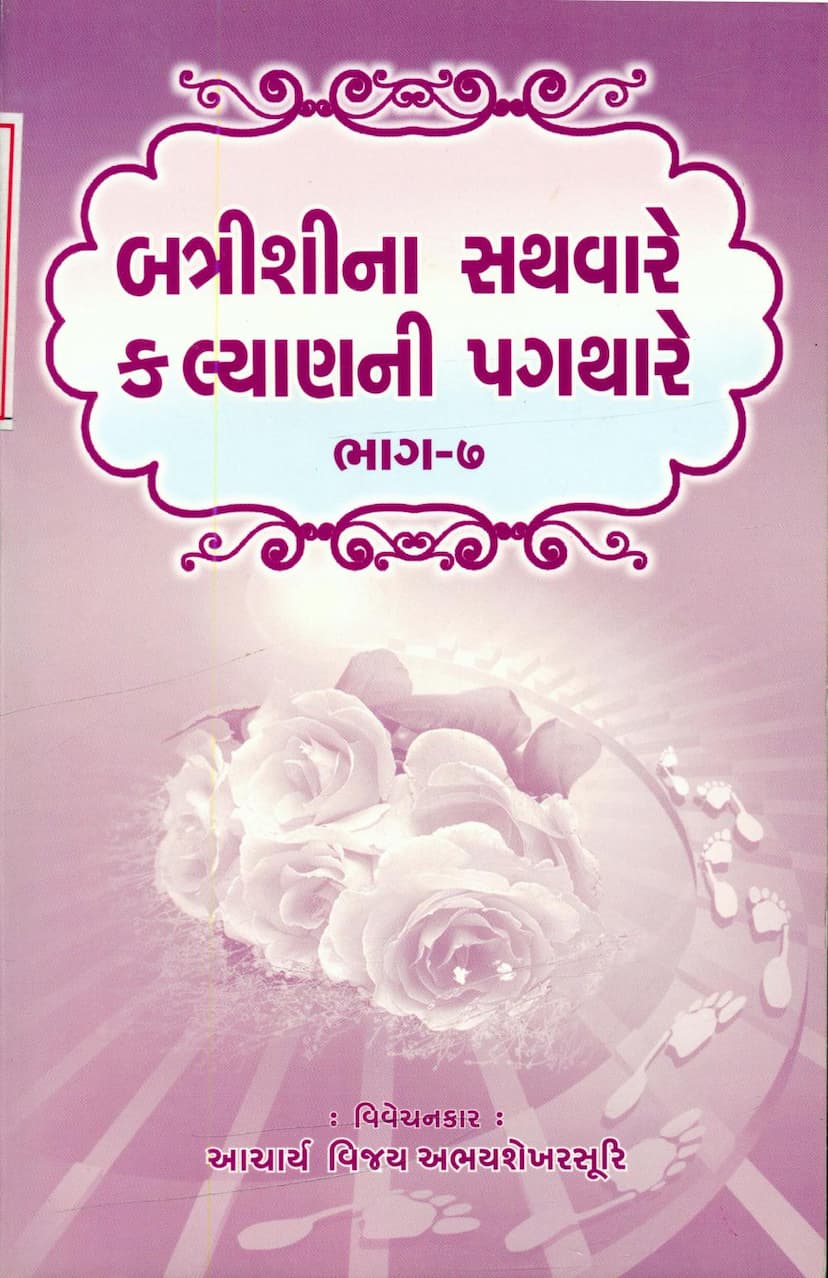Battrishina Sathware Kalyanni Pagthare Part 07
Added to library: September 1, 2025

Summary
This document is the seventh part of a series titled "Battriśīnā Sathavāre Kalyāṇnī Pāgthāre" (On the Path to Welfare with the Battriśī), authored by Acharya Vijay Abhayashekharsuri. The book is published by Divyadarshan Trust. This particular volume covers the 14th to 17th Battriśī (sections or chapters) of the larger work.
The series is based on the "Dvātriśat Dvārnśikā Granth" by Mahopadhyaya Shrimad Yashovijayji Maharaj, with commentary provided by Acharya Vijay Abhayashekharsuri, a disciple of Acharya Vijay Prem-Bhuvana-Dharmatu-Jayashekharasuri. The book aims to present complex philosophical concepts from Jain scriptures in a simple and accessible language for the general public.
Key Themes and Content Covered (based on the provided text):
- Focus on "Apunarbhandhak" (Non-re-binder): A significant portion of the text discusses the concept of "Apunarbhandhak" in Jainism. This refers to souls that will no longer bind themselves with karmas, particularly those that lead to repeated cycles of birth and death. The text explains that an apunarbhandhak soul is one who will never again bind the mohanīya karma with an extremely long duration (up to 70 koti-koti sagaropam). This state is achieved after the removal of defects associated with the "bhavābhinandī" (one who rejoices in worldly existence) soul.
- Progression of Soul's Development: The text outlines a progression of souls, moving from dvibandhak (binding karma twice), sakṛdbandhak (binding karma once), to apunarbhandhak.
- Qualities of Apunarbhandhak: An apunarbhandhak soul is described as being like the waxing moon in the bright fortnight, with progressively increasing virtues like generosity and compassion. They are characterized by a natural inclination towards liberation (muktiadvesha) and a strong desire for welfare (kalyāṇ ashay).
- Role of Purushartha (Effort) vs. Natural Progression: The text explores whether the state of apunarbhandhak is achieved through effort or through natural progression of time. It suggests that while effort is important, there's also a natural temporal progression in shedding karmic impurities.
- Margapatit and Margabhimukh (Fallen from the Path and Moving towards the Path): These concepts are discussed in relation to the soul's journey. A margapatit soul has entered the path of spiritual progress, while a margabhimukh soul is inclined towards it.
- The Nature of Purvaseva (Previous Service): The text differentiates between true (anupacharit) purvaseva performed by apunarbhandhak souls, which directly leads to liberation, and upacharit (symbolic) purvaseva performed by other souls, which appears similar but doesn't have the same direct efficacy.
- Distinction between Jain and Other Philosophies: The commentary engages with concepts found in other philosophical schools like Sankhya and Buddhism, highlighting Jain distinctions, particularly concerning apunarbhandhak and the nature of the soul.
- The Importance of Shraddhā (Faith) and Shastras (Scriptures): The text emphasizes the role of faith in scriptures and the importance of understanding the nuances of Jain philosophy, which often involves anekāntavāda (non-one-sidedness).
- The Role of Ishānugraha (Grace of God/Supreme Being) and Purushartha (Self-Effort): The later parts of the text delve into discussions about divine grace versus self-effort in spiritual progress, drawing comparisons with Patanjali's Yoga philosophy and ultimately concluding with the Jain perspective where both are considered important, but with a clear emphasis on the soul's own actions and understanding. The text discusses the concept of Ishāna and its relationship to achieving yoga and spiritual liberation.
- Critique of other Philosophies: The commentary critically examines other philosophical views, particularly regarding creation, the nature of the soul, and the means to liberation, contrasting them with the Jain viewpoint.
- Three Types of Pure Conduct (Anushthana): The text details three types of pure conduct: vishayashuddha (pure in objective), swaroopashuddha (pure in form), and anubandhashuddha (pure in consequence/continuity).
- The concept of Tathābhavyatva (Destined to be Blessed/Enlightened): This concept is discussed in relation to the soul's progression and its eventual attainment of liberation, explaining how it influences the timing and nature of spiritual development.
- The Nature of Samadṛṣṭi (Right View): The text elaborates on the characteristics and understanding of a soul with right perception, including their inclination towards scriptures, their understanding of the transient nature of worldly pleasures, and their devotion.
- The Concept of Ishvara in Jainism: The commentary discusses the Jain understanding of Īśvara (God) as a pure, liberated soul, contrasting it with other philosophical definitions, and clarifies the concept of ishānugraha (divine grace) within the Jain framework.
- Theological Debates: The text engages with theological debates, particularly contrasting Jainism's view on the soul, karma, and liberation with those of schools like Sankhya, Vedanta, and Buddhism.
Overall Purpose: The series "Battriśīnā Sathavāre Kalyāṇnī Pāgthāre" aims to provide a comprehensive and accessible commentary on Jain spiritual principles. This seventh part continues the detailed exposition, focusing on the nuanced understanding of the soul's journey towards liberation, the nature of karmic bondage, and the path to spiritual realization as taught in the Jain tradition. The commentary by Acharya Abhayashekharsuri makes these profound teachings understandable for a wider audience.